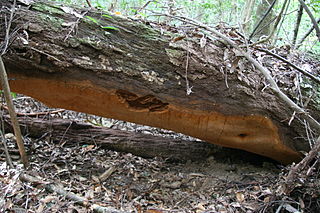Related Research Articles

The Hymenochaetales are an order of fungi in the class Agaricomycetes. The order in its current sense is based on molecular research and not on any unifying morphological characteristics. According to one 2008 estimate, the Hymenochaetales contain around 600 species worldwide, mostly corticioid fungi and poroid fungi, but also including several clavarioid fungi and agarics. Species of economic importance include wood decay fungi in the genera Phellinus and Inonotus sensu lato, some of which may cause losses in forestry. Therapeutic properties are claimed for Inonotus obliquus ("chaga") and Phellinus linteus, both of which are now commercially marketed.

The Polyporaceae are a family of poroid fungi belonging to the Basidiomycota. The flesh of their fruit bodies varies from soft to very tough. Most members of this family have their hymenium in vertical pores on the underside of the caps, but some of them have gills or gill-like structures. Many species are brackets, but others have a definite stipe – for example, Polyporus badius.

Inonotus cuticularis is a species of fungus in the family Hymenochaetaceae. A plant pathogen, it has a circumpolar distribution, and is found in the temperate zone from eastern U.S. and Canada to Japan, China, Russia and south to central Europe.

The Hymenochaetaceae are a family of fungi in the order Hymenochaetales. The family contains several species that are implicated in many diseases of broad-leaved and coniferous trees, causing heart rot, canker and root diseases, and also esca disease of grapevines. According to a standard reference text, the family contains 27 genera and 487 species.

Inonotus is a genus of fungi in the family Hymenochaetaceae. The genus, described by Petter Karsten in 1879, is estimated to contain about 80 species sensu lato and 30 species sensu stricto.

Phylloporia is a genus of polypore fungi in the family Hymenochaetaceae. A 2012 estimate placed 23 species in the genus; this number was increased to 30 by 2015.

Porodaedalea is a genus of fungi in the family Hymenochaetaceae. The genus was circumscribed by American mycologist William Alphonso Murrill in 1905.

Haploporus is a genus of poroid fungi in the family Polyporaceae.
Megasporoporia is a genus of four species of crust fungi in the family Polyporaceae. The genus is characterized by its large spores, and dextrinoid skeletal hyphae.

Skeletocutis is a genus of about 40 species of poroid fungi in the family Polyporaceae. The genus has a cosmopolitan distribution, although most species are found in the Northern Hemisphere. Skeletocutis causes a white rot in a diverse array of woody substrates. Their fruit bodies grow as a crust on the surface of the decaying wood. Sometimes the edges of the crust are turned outward to form rudimentary bracket-like caps.

Phellinus ellipsoideus is a species of polypore fungus in the family Hymenochaetaceae, a specimen of which produced the largest fungal fruit body ever recorded. Found in China, the fruit bodies produced by the species are brown, woody basidiocarps that grow on dead wood, where the fungus feeds as a saprotroph. The basidiocarps are perennial, allowing them to grow very large under favourable circumstances. They are resupinate, measuring 30 centimetres (12 in) or more in length, though typically extending less than a centimetre from the surface of the wood. P. ellipsoideus produces distinct ellipsoidal spores, after which it is named, and unusual setae. These two features allow it to be readily differentiated microscopically from other, similar species. Chemical compounds isolated from the species include several steroidal compounds. These may have pharmacological applications, but further research is needed.

Inonotus tamaricis is a species of fungus in the family Hymenochaetaceae. A plant pathogen, it grows on dead and living Tamarix species, and is found in Southern Europe, North Africa, Syria and Senegal, Southern Asia and east to China.

Phellopilus is a fungal genus in the family Hymenochaetaceae. Circumscribed in 2001, the genus is monotypic, containing the single widespread species Phellopilus nigrolimitatus.
Tropicoporus is a genus of fungi in the family Hymenochaetaceae. It was circumscribed in 2015 with Tropicoporus excentrodendri as the type species, and six additional species transferred from Inonotus.
Tropicoporus tropicalis is part of the family Hymenochaetaceae, and was recently renamed to Tropicoporus tropicalis from Inonotus tropicalis, which is part of the Inonotus clade B. Tropicoporus tropicalis is a wood-decaying basidiomycetes that rarely causes disease in animals and human, and is commonly found in humid climate such as Brazil. In its natural environment, the fungus is associated with white rot woody angiosperms, and has its annual fruiting body on tree trunks and branches. Tropicoporus tropicalis has two kinds of hyphae, generative and skeletal, that lack clamp connections.
Inonotus rigidus is a species of fungus in the family Hymenochaetaceae. It is distinguished by its resupinate and rigid basidiocarps, its yellow pore surface, being microscopically ellipsoid and yellowish brown, its thick-walled basidiospores, and by lacking both setal hyphae and hymenial setae.
Inonotus chrysomarginatus is a species of fungus in the family Hymenochaetaceae. It is distinguished by having an annual to perennial growth habit, pileate basidiocarps, setal hyphae and hooked hymenial setae, and sublobose, yellowish, thick-walled cyanophilous basidiospores.

Inocutis is a genus of nine species of polypore fungi in the family Hymenochaetaceae.
Megasporoporia minuta is a species of crust fungus in the family Polyporaceae. Found in the Guangxi Autonomous Region of southern China, it was described as a new species in 2008 by mycologists Xu-Shen Zhou and Yu-Cheng Dai. The fungus produces annual to biennial fruit bodies with small pores, numbering 6–8 per millimetre. The spores are cylindrical to oblong-ellipsoid and measure 7.7–9.7 by 3.6–4.9 μm. The hymenium lacks both hyphal pegs and dendrohyphidia.

Nanhaipotamon is a genus of freshwater crabs, in the subfamily Potamiscinae, found in southern China and Taiwan. As of 2018, 18 species have been described. The genus is named after the South China Sea, for it occurs mostly in coastal areas.